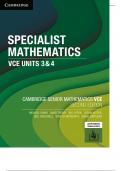Summary
Summary Cambridge Specialist Mathematics VCE Units 3&4 Second Edition 2024
- Course
- Institution
Cambridge Specialist Mathematics VCE Units 3&4 Second Edition provides a complete teaching and learning resource for the VCE Study Design to be first implemented in 2023. It has been written with understanding as its chief aim, and with ample practice offered through the worked examples and exer...
[Show more]



